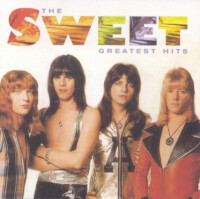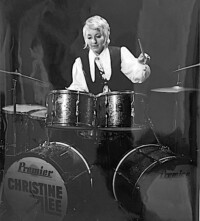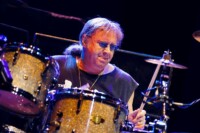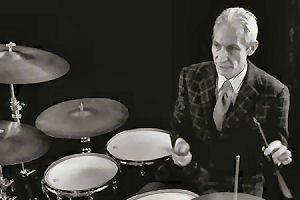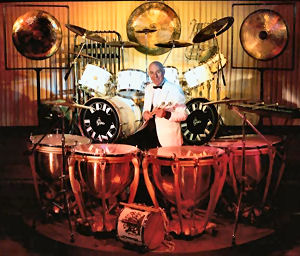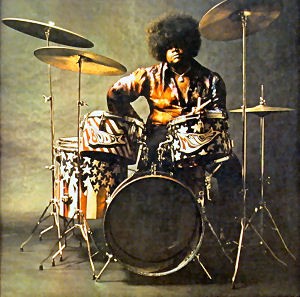 We’re moving quite a bit closer to the present day with the subject of this month’s ‘Groovers and Shakers’. Buddy Miles was very much a child of the sixties inasmuch as that was when he came to people’s notice, including mine. It’s no secret he’s listed up there at the top of my favourite drummers list and he inadvertently showed me a thing or two.
We’re moving quite a bit closer to the present day with the subject of this month’s ‘Groovers and Shakers’. Buddy Miles was very much a child of the sixties inasmuch as that was when he came to people’s notice, including mine. It’s no secret he’s listed up there at the top of my favourite drummers list and he inadvertently showed me a thing or two.
He was born on September 5th 1947 in Omaha, Nebraska and, like just about all of the guys so far featured in this piece, was a child prodigy. He took up the drums at nine years old and by the time he was twelve he was playing with his dad’s jazz band called the ‘Bebops’. George senior was a bass player who played with Duke Ellington, Count Basie, Dexter Gordon and Charlie Parker. As it says in the heading, his real name was George Allen Miles jnr and his aunt optimistically and wisely gave him the nickname Buddy for hopefully obvious reasons. He was of course listening to jazz at home in Sioux Falls, South Dakota but at the same time getting into R&B music and in particular drummers Al Jackson and Bernard Purdie. The internet knows nothing about his musical education but since he also played guitar l’m guessing he must have had some training.
What those R&B guys were playing stimulated him enough to drop-out of high school at 17 and hit the road playing drums first in 1964 with Ruby and The Romantics of “My Day Will Come” fame, then with various prestigious R&B outfits including the Ink Spots, the Delfonics and Wilson Pickett. There is a suggestion on the internet that he played on the Jaynetts’ record “Sally Go Round the Roses” with the infamous B-side which was simply the backing track retitled ‘”Sing Along with Sally Go Round the Roses”! I say it’s a suggestion because the record came out in 1963, was recorded in New York when Buddy was 16, and furthermore the arranger, Artie Butler, insists he played everything on it.
Anyway, it was while he was playing with the Delfonics in Montreal in 1964, that Buddy met Jimi Hendrix for the first time who was also on the road playing guitar and touring with the Isley Brothers. Evidently they jammed together and exchanged phone numbers although nothing happened because not long after Jimi left for England and formed the Jimi Hendrix Experience.
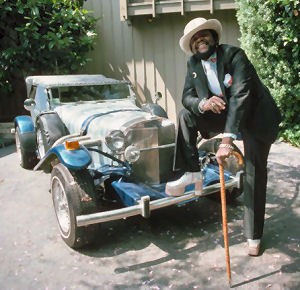 Sometime around 1967 Buddy began to break through not as a sideman, but as a contracted artist and having been spotted by Michael Bloomfield while he was playing with Wilson Pickett he joined the guitarist in The Electric Flag. Here he not only played drums, he sang lead, and recorded the albums “A Long Time Comin’” and “An American Music Band”. Bloomfield had been in Paul Butterfield’s Blues band but wanted what he called an American band with a horn section, the Electric Flag’s debut was at the Monterey Pop Festival later that year and Jimi Hendrix was also appearing.
Sometime around 1967 Buddy began to break through not as a sideman, but as a contracted artist and having been spotted by Michael Bloomfield while he was playing with Wilson Pickett he joined the guitarist in The Electric Flag. Here he not only played drums, he sang lead, and recorded the albums “A Long Time Comin’” and “An American Music Band”. Bloomfield had been in Paul Butterfield’s Blues band but wanted what he called an American band with a horn section, the Electric Flag’s debut was at the Monterey Pop Festival later that year and Jimi Hendrix was also appearing.
We know Buddy and Bloomfield fell out eventually and The Electric Flag didn’t stay together for long and Buddy soon went on to do his own thing with the Buddy Miles Express, whose first two albums, ‘Expressway To Your Skull’ and ‘Electric Church’, it turns out were co-produced by Hendrix. Nothing if not diverse, not long after this Buddy played with John McLaughlin on the ‘Devotion’ album and famously on some of the Jimi Hendrix Experience’s third album – ‘Electric Ladyland’. He substituted for Mitch Mitchell on “Rainy Day, Dream Away” and “Still Raining, Still Dreaming.”
Not too long after the release of the ground-breaking Electric Ladyland album Noel Redding and Mitch Mitchell left the band. All three of the guys had become disenchanted but Hendrix’s solution to the problem was to enrol Buddy and a bass player called Billy Cox into a brand new entity called ‘A Band of Gypsys’. They recorded an album called ‘Live at the Fillmore East’ on New Year’s Eve 1969 which for my money was Hendrix at his best and went on to sell very well. My American drummer friends think it’s an act of sacrilege for me to say this, but I feel Buddy and Billy’s deeply-rooted, neo-funk playing in the ‘Gypsys’ suited Hendrix’ aggressive guitar style better than the Experience did. Sorry Mitch!
My favourite track is an anti-war song called “Machine Gun” but one version of “Power to Love” has a twist where the guys utilise a big-band device called the ‘long crotchet’ where, having played the intro and paused on an upbeat they stretch the time before they come in on the downbeat. It’s brilliant.
Buddy says about the change of personnel: “I think Jimi wanted a more simplified version of drums after a while and I think that’s the reason he wanted me to be the drummer in Band of Gypsys.” There was unfortunately only one album from the ‘Band of Gypsys’ and as I said for my money this was funky rock music and showed Buddy and Hendrix at their very best.
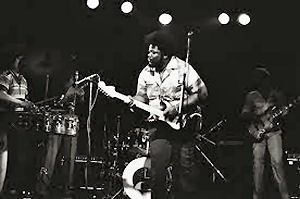 There’s a story Frank Zappa told about Buddy visiting him in the studio with Jimi, falling asleep on the couch for an hour and a half, missing the whole thing and waking up and leaving!
There’s a story Frank Zappa told about Buddy visiting him in the studio with Jimi, falling asleep on the couch for an hour and a half, missing the whole thing and waking up and leaving!
The ‘Gypsys’ played straight ahead groove-based tunes including Buddy’s own “Them Changes,” and the previously mentioned anti-war song Machine Gun. All in all you might say Hendrix was exploring a more soulful direction and one with an unmissable offbeat. But unfortunately Jimi’s premature death in September 1970 put an end to what I already said I felt was Buddy and Jimi’s tour de force.
He moved to Chicago in 1967 and it was there at the very beginning of 1970 with Argent that I played with and I met him for the first time. I was always much taken by his approach to “Psychedelic Blues Rock” drumming which was nothing like anything I’d ever experienced before. I know this isn’t about me but in those halcyon days of touring America we’d be sharing bills with many CBS artists including jazz/rock drummers like Lennie White, Alphonse Mouzon and Narada Michael Walden – all playing in more or less the same funky way that Sly and the family Stone had popularised. Buddy Miles did it slightly differently though, with more anger and insistence – and, IMHO Buddy Miles was there first.
To be honest he was considerably rockier than those other guys and he had much more attitude. He had a relentless and attacking way of pushing very straight eights on the hi-hat giving a straight ahead feel. His hi hat was relentlessly pushing forwards with his offbeat very closely behind.
These were the days of the Afro haircut and Buddy’s was bigger than most. He was always a very big guy and he coaxed a lot of sound out of what looked to be a little five-piece Rogers set which actually wasn’t small at all. He towered over it and it was distinctively and patriotically decorated in red, white and blue stars and stripes.
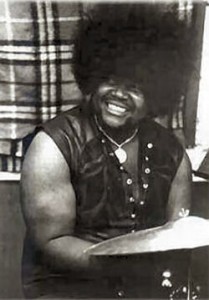 This wasn’t the only unusual thing about the set, I can’t find any evidence he was an endorser in the sixties but depending on when he bought it, it was either a ‘Top Hat’ or a ‘Londoner’ although neither of these had single-headed toms. It was based on an otherwise standard 20, 12, 13, 16 Rogers set with what my guess is ‘converted’ single-headed toms, Swivomatic holders and Zildjian cymbals. But there’s an interesting story behind it. It was originally covered in black plastic and well-founded rumour has it that the stars and stripes weren’t painted on at all. Roy Harte, who was Remo Belli’s partner in Hollywood’s Drum City, simply put stickers on the drums – now there’s an avenue for some enterprising drum person to explore! Roy Harte may also have taken the bottom heads off the toms and removed the lower nutboxes. As far as snare drums are concerned the only one I can positively identify was a Ludwig 400 although possibly not with the Stars and Stripes kit.
This wasn’t the only unusual thing about the set, I can’t find any evidence he was an endorser in the sixties but depending on when he bought it, it was either a ‘Top Hat’ or a ‘Londoner’ although neither of these had single-headed toms. It was based on an otherwise standard 20, 12, 13, 16 Rogers set with what my guess is ‘converted’ single-headed toms, Swivomatic holders and Zildjian cymbals. But there’s an interesting story behind it. It was originally covered in black plastic and well-founded rumour has it that the stars and stripes weren’t painted on at all. Roy Harte, who was Remo Belli’s partner in Hollywood’s Drum City, simply put stickers on the drums – now there’s an avenue for some enterprising drum person to explore! Roy Harte may also have taken the bottom heads off the toms and removed the lower nutboxes. As far as snare drums are concerned the only one I can positively identify was a Ludwig 400 although possibly not with the Stars and Stripes kit.
Buddy also contributed to a number of the ‘stoner’ comedians Cheech and Chong’s songs. Most notably ”Lost Due To Incompetence (Theme for a Big Green Van)” in the late seventies from their film ‘Up In Smoke’.
In 1972 Buddy Miles co-headlined an album recorded on an extinct volcano in Hawaii and called succinctly, ‘Carlos Santana and Buddy Miles: Live!’ Between 1976 and 1978, he was with him and again from 1982 to 1985. Around this time he was also fitting in sessions for George Clinton, Stevie Wonder, Bootsy Collins, Barry White, John McLaughlin, Eric Clapton and eventually David Bowie.
But something came along which may have contributed to his possibly self-styled nickname: ‘the baddest of the bad’ – he went to jail for seven years for grand theft auto and stealing clothes from Nudies Rodeo tailoring and rock’n’roll clothing shop in Los Angeles. (For those into that sort of thing Nudies made stage costumes for Elvis.)
Anyhow he used his time wisely inside both Chino and San Quentin prisons forming bands and teaching music.
However, evidently undaunted by his spell inside, in 1986 Buddy Miles bounced back on his feet because not long after his release he successfully auditioned for a singing part in the most popular TV adverts ever: the California Raisins commercials. (Including a great version of Marvin Gaye’s single “I heard it through the Grapevine”.) He sang lead on and produced two million-selling California Raisins albums ‘California Raisins’ and ‘Meet the Raisins’, both featuring 1960”s R&B covers.
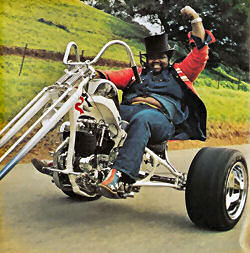 After this he had his first stint with Carlos Santana staying through 1986 and 1987 and singing on the album Freedom. The next time I saw him was when I was with the Kinks at Lorelei, an open-air gig overlooking the Rhine in Germany. Buddy wasn’t drumming any more but singing lead and playing left-handed, upside-down guitar with Santana! Curious this because he set up his drums right handed but it’s impossible to say from videos whether he, like Ringo, led with his left hand.
After this he had his first stint with Carlos Santana staying through 1986 and 1987 and singing on the album Freedom. The next time I saw him was when I was with the Kinks at Lorelei, an open-air gig overlooking the Rhine in Germany. Buddy wasn’t drumming any more but singing lead and playing left-handed, upside-down guitar with Santana! Curious this because he set up his drums right handed but it’s impossible to say from videos whether he, like Ringo, led with his left hand.
After that he disappeared from my sight but he still recorded with various people and keeping on the road with his own blues/rock band called the Blues Berries, and doing a get together gig with The Band of Gypsies – without Hendrix of course. He also made an album with Billy Cox in 2006. It wasn’t until I was at the NAMM summer show in Austin around this time with Traps drums that I bumped into him again. Instead of the usual indiscriminate thunder of drums you unfortunately hear most of at music trade shows I heard some funky drumming coming from somebody else’s stand behind me. When the perpetrator came around the corner I didn’t immediately recognise him because he was in a wheelchair as a result of a stroke but, when he hit one of my sets I knew immediately who he was – Buddy Miles – aka (by some) as ‘Sugah Bear’.
I’d recognise his fatback playing anywhere!
So what tracks should you listen to for the essence of Buddy Miles? Well it’s pretty simple, just listen to any of the tracks I’ve mentioned! But Youtube has him singing and playing a Neil Young song called “Down By The River” along with a Rufus Thomas song called “Memphis Train” and for a soulful vocal performance try his version of The Everley brothers song “Let It Be Me”. If you want a lesson in Rock/Blues drumming check out a 1969 concert with Buddy Guy and Jack Bruce where you’ll be interested to know he had single headed toms and bass drum.
Buddy Miles died from congestive heart failure on February 26, 2008 in Austin, Texas. He was just 60 and the only drummer to have played with Jimi Hendrix and The California Raisins.
Bob Henrit
December 2015

